
Customer Health Scores and Early Warning Systems in SaaS

by
Wiktoria Slowikowska
Oct 30, 2024
Identify and convert your most valuable users
Sign Up
Retaining customers is just as important as acquiring new ones. With increasing competition and changing customer expectations, businesses need effective strategies to ensure their customers are satisfied and engaged.
Customer Health Scores and Early Warning Systems are two essential tools that can help SaaS companies monitor customer satisfaction, predict churn, and proactively engage at-risk users. In this article, we'll explore these concepts in depth, detailing their importance and providing actionable steps to implement them effectively.
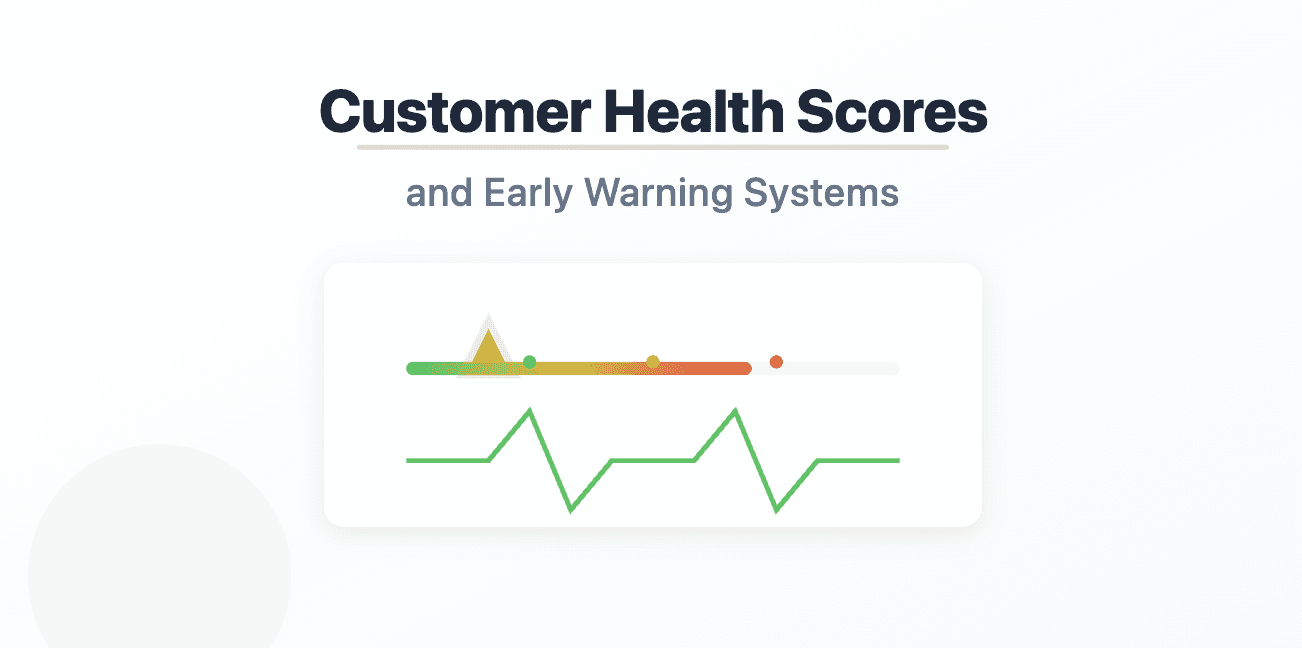
What Are Customer Health Scores?
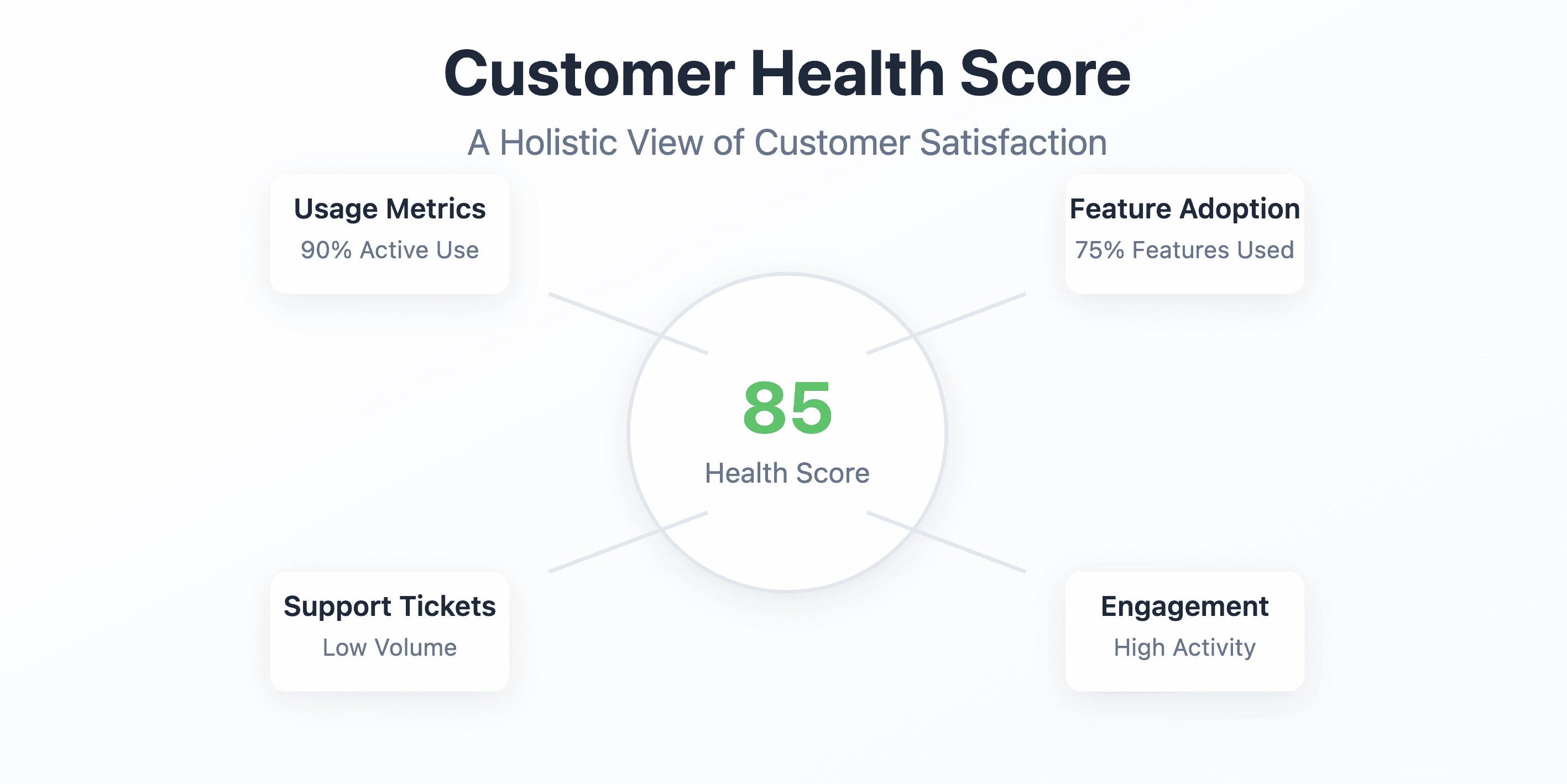
Customer Health Scores are metrics that indicate the overall satisfaction and engagement level of a customer with your product. These scores are not just numbers; they encapsulate a customer’s journey and reflect their likelihood of renewing their subscription. By assessing multiple factors, businesses can gauge the “health” of each customer account.
Key Components of Customer Health Scores
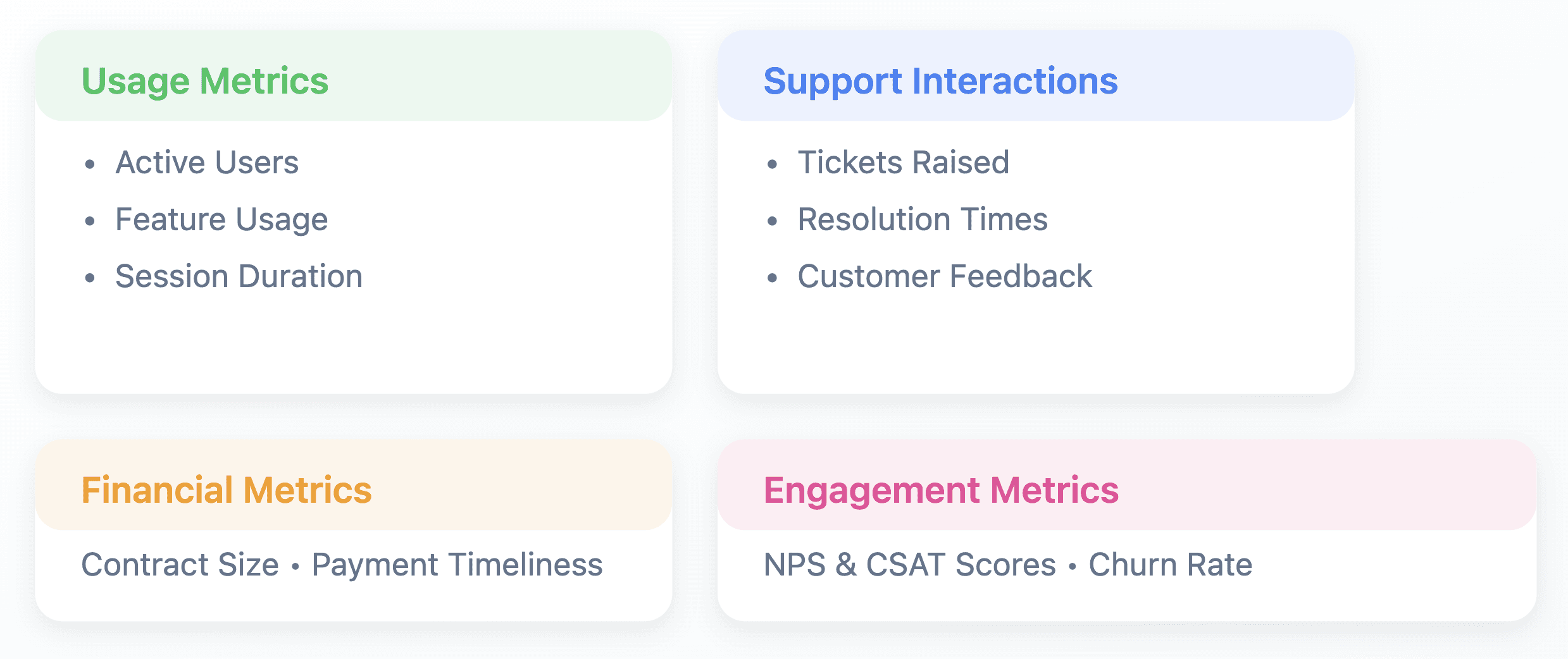
Usage Metrics:
Active Users: Monitor how many users are actively using your product on a daily or monthly basis.
Feature Usage: Analyze which features are being used most frequently and which are being ignored.
Session Duration: Evaluate how long customers spend in the application during each session.
Support Interactions:
Tickets Raised: Track the number of support tickets a customer raises. A high number could indicate dissatisfaction.
Resolution Times: Measure how quickly issues are resolved. Longer resolution times can correlate with frustration.
Customer Feedback: Collect qualitative feedback through surveys or direct communication.
Financial Metrics:
Contract Size: Larger contracts might warrant more attention and higher engagement levels.
Payment Timeliness: Track whether payments are made on time. Late payments can signal a potential risk.
Engagement Metrics:
NPS and CSAT Scores: Regularly conduct Net Promoter Score (NPS) and Customer Satisfaction Score (CSAT) surveys to capture customer sentiment.
Churn Rate: Calculate the percentage of customers that cancel their subscriptions over a specific period.
Why Customer Health Scores Matter

Proactive Engagement: By regularly assessing customer health scores, teams can proactively reach out to customers showing signs of dissatisfaction, reducing the likelihood of churn.
Resource Allocation: Understanding which customers are struggling can help businesses allocate resources effectively, ensuring that at-risk customers receive the support they need.
Improved Product Development: By analyzing the data leading to higher health scores, companies can focus on enhancing features that are most important to their customers.
What Are Early Warning Systems?
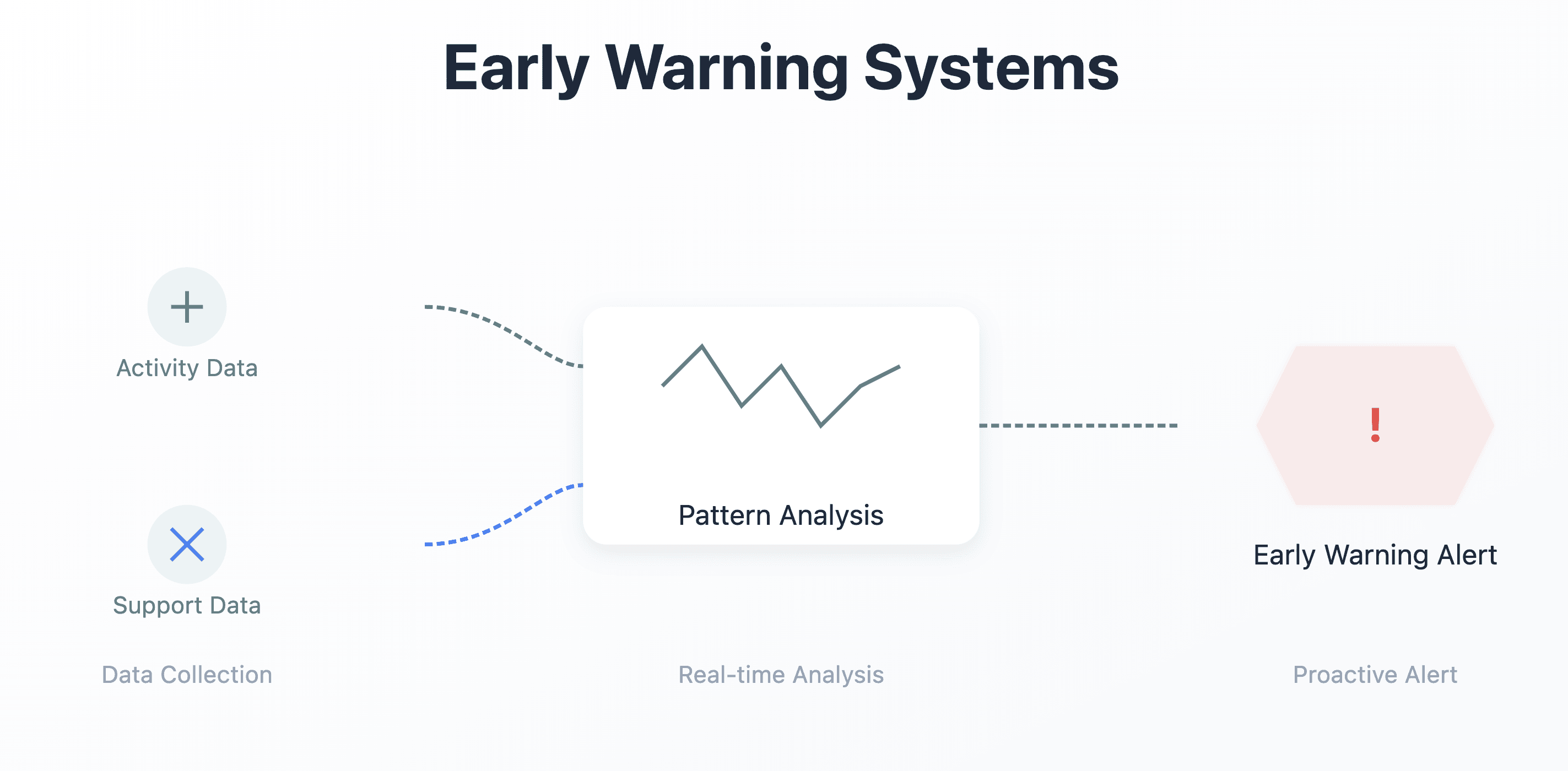
Early Warning Systems are proactive tools or processes that alert businesses to potential customer churn before it occurs. These systems analyze customer data and behavior, identifying patterns that may indicate dissatisfaction.
Key Components of Early Warning Systems
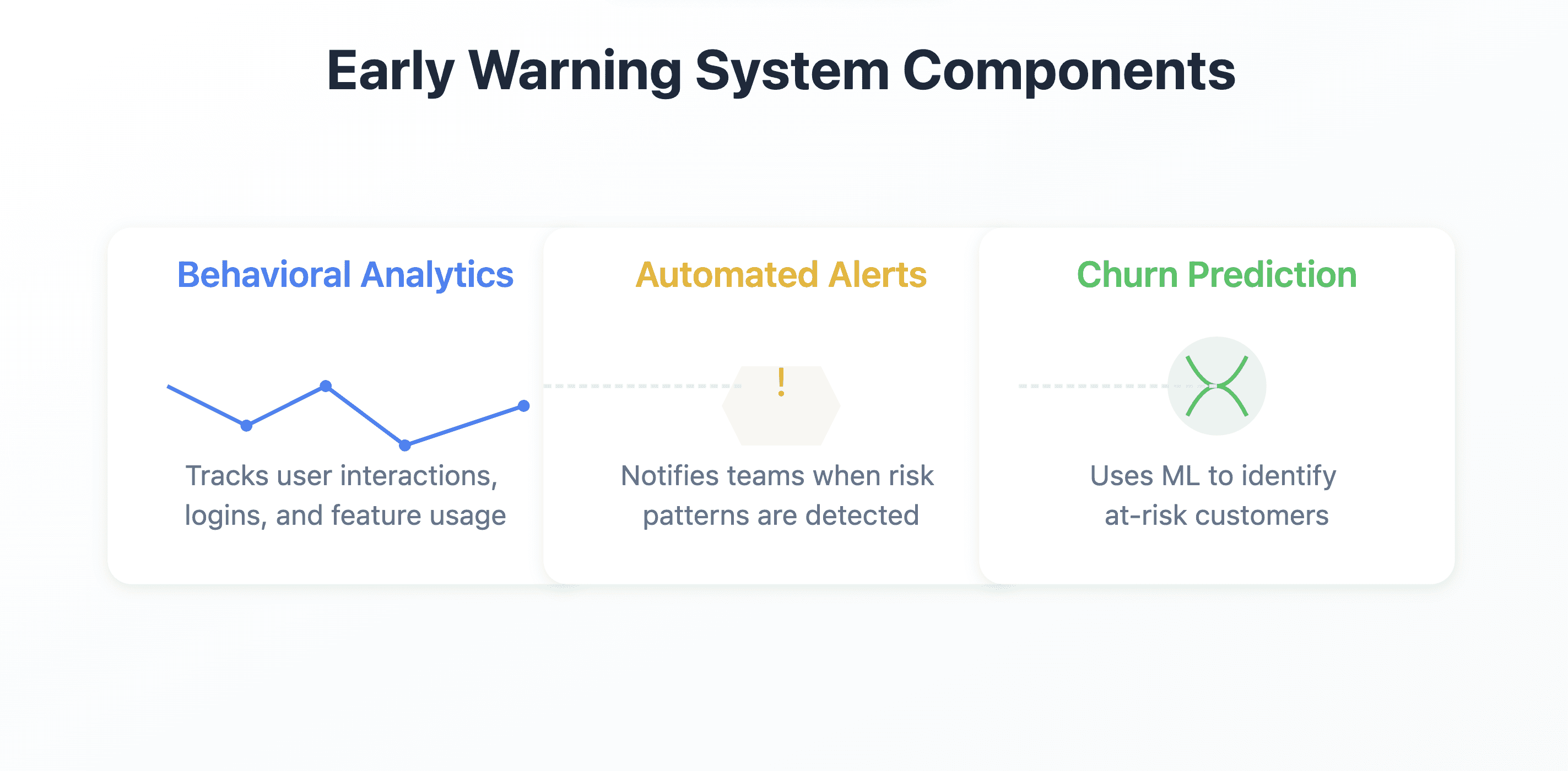
Behavioral Analytics:
Tracking User Interaction: Monitor how users interact with your product, such as login frequency, feature usage, and task completion rates.
Identifying Patterns: Use analytics tools to identify trends, such as decreased login frequency or reduced feature usage, which can signal a risk of churn.
Automated Alerts:
Set up alerts for customer success teams when certain behaviors are detected. For instance, if a customer hasn’t logged in for a week, an alert can prompt the team to reach out.
Churn Prediction Models:
Use machine learning algorithms to analyze historical data and predict which customers are at a higher risk of leaving. This data can help teams focus their efforts on at-risk accounts.
Why Early Warning Systems Matter
Timely Interventions: With real-time alerts, customer success teams can address issues quickly, before they lead to churn. For example, if a customer’s usage drops significantly, the team can reach out to re-engage them.
Informed Decision-Making: Data-driven insights into customer behavior enable businesses to make informed decisions about resource allocation and support strategies.
Building Stronger Relationships: Proactive engagement shows customers that you value their success and are willing to support them, strengthening the relationship.
Building Customer Health Scores and Early Warning Systems

Now that we understand the importance of customer health scores and early warning systems, let’s discuss how to implement them effectively. Here are actionable steps tailored for SaaS businesses.
Step 1: Define Your Customer Health Score Metrics
Gather Stakeholders: Collaborate with customer success, sales, product, and marketing teams to define the metrics that reflect customer health. Each team can provide insights based on their interactions with customers.
Select Key Metrics: Choose a mix of quantitative and qualitative metrics to create a holistic health score. For example, you might decide to include:
Monthly active users (MAU)
Feature adoption rates
Support tickets raised in the last month
Recent NPS scores
Determine Weighting: Assign weightings to each metric based on their importance. For example, if usage metrics are more critical than support interactions, you might assign them a higher percentage in the overall health score calculation.
Step 2: Develop the Scoring System
Create a Scoring Formula: Establish a formula that converts your selected metrics into a score. A simple approach might be:
Customer Health Score=(W1×M1)+(W2×M2)+...+(Wn×Mn)
Where WWW represents the weight of each metric, and MMM is the metric score (on a scale of 0 to 100).Set Health Score Ranges: Define ranges for the health scores, such as:
80-100: Healthy
60-79: At Risk
0-59: Critical
Implement in a Dashboard: Use business intelligence tools or customer success platforms like Gainsight or ChurnZero to create a dashboard displaying customer health scores in real-time.
Step 3: Establish Data Collection Processes
Integrate Data Sources: Ensure all relevant data sources are integrated. This may include:
Your product’s usage analytics (e.g., Mixpanel or Hyperaktiv)
Customer support systems (e.g., Zendesk or Freshdesk)
Payment systems (e.g., Stripe or PayPal)
Automate Data Collection: Set up automated data collection processes to ensure health scores are updated regularly. For instance, using APIs or ETL tools like Segment can streamline data ingestion.
Step 4: Build the Early Warning System
Identify At-Risk Behaviors: Determine which behaviors typically indicate churn. For instance:
Fewer than three logins in the last month
Reduced engagement with key features
Increase in support tickets related to product functionality
Create Alerts: Implement an alert system using tools like Slack or email notifications. For example, you might configure alerts for the customer success team to be notified when a customer’s health score drops below a certain threshold.
Leverage Predictive Analytics: Utilize machine learning models to analyze historical data and predict churn.
Regular Review and Adjustment: Periodically review the effectiveness of your early warning system. Analyze which alerts resulted in successful interventions and which did not. Adjust thresholds and alerts based on this feedback.
Step 5: Engage At-Risk Customers
Develop Playbooks: Create playbooks for customer success teams outlining steps to take when a customer shows signs of churn. For example:
Reach out within 24 hours: If a customer’s health score drops, contact them immediately.
Schedule a call: Offer to discuss their experience and address any concerns.
Personalized Communication: Tailor your outreach based on the specific issues identified in the health score metrics. For instance, if a customer has not used a key feature, provide resources or training to help them understand its value.
Feedback Loop: After engaging at-risk customers, gather feedback to understand their concerns. Use this information to improve your product and support processes continuously.
HubSpot’s Use of Customer Health Scores
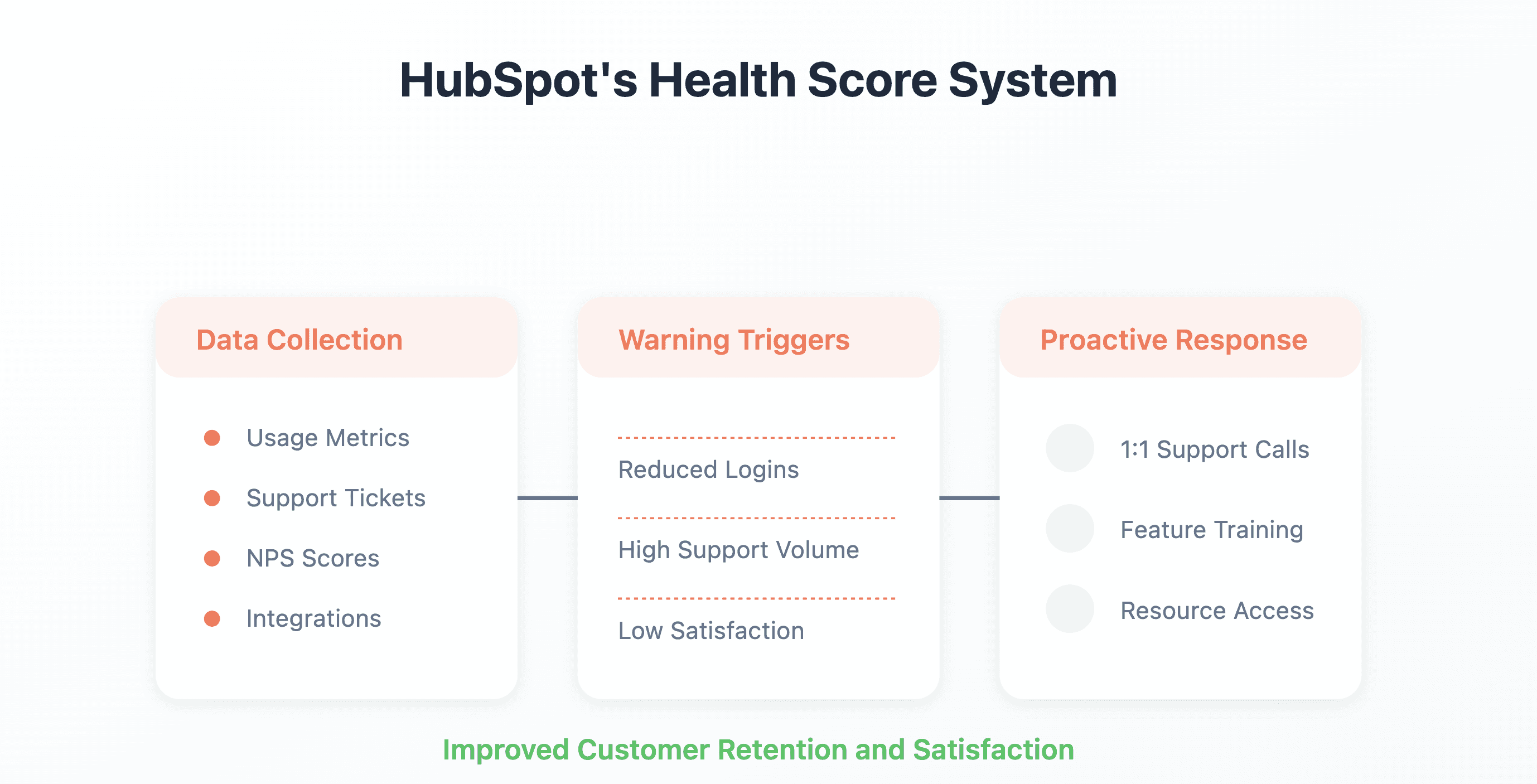
HubSpot, a leading inbound marketing and sales platform, provides tools for marketing, sales, customer service, and CRM. With thousands of customers relying on its services, maintaining high customer satisfaction and retention is crucial for their business model.
Implementation of Customer Health Scores:
HubSpot developed a comprehensive Customer Health Score system to monitor customer engagement and satisfaction levels. They identified key metrics that could influence customer retention, including:
Usage Data: Tracking the frequency and depth of product usage, such as the number of emails sent through their platform, active integrations, and the use of various marketing tools.
Support Interactions: Monitoring customer support tickets and response times to gauge customer frustration or satisfaction.
Feedback Scores: Collecting Net Promoter Score (NPS) and Customer Satisfaction Score (CSAT) data through surveys to assess overall customer sentiment.
Early Warning System in Action:
Using these metrics, HubSpot set up an Early Warning System that flags accounts with declining health scores. For instance:
If a customer who typically logs in daily suddenly reduces their usage to just once a week, the system triggers an alert.
If the support tickets from a specific customer increase significantly or if they provide negative feedback in surveys, their health score drops.
Proactive Engagement:
When customers are flagged as "at-risk," HubSpot’s Customer Success team proactively reaches out to address any concerns. For example:
They might schedule a one-on-one call with the customer to discuss their challenges and provide tailored solutions or training on underutilized features.
HubSpot might offer exclusive access to webinars or resources that help the customer maximize their usage of the platform.
Outcome:
By implementing Customer Health Scores and an Early Warning System, HubSpot significantly improved its customer retention rates. The proactive approach allowed them to identify issues before they escalated, resulting in better customer satisfaction and loyalty. As a result, HubSpot has maintained a strong reputation and continued to grow its customer base.
Takeaway
This example demonstrates how a SaaS company can effectively use Customer Health Scores and Early Warning Systems to enhance customer engagement, identify at-risk accounts, and improve overall retention. By proactively addressing customer needs and concerns, businesses can build lasting relationships and drive long-term success.
Conclusion
Understanding and implementing Customer Health Scores and Early Warning Systems is crucial for customer retention and satisfaction. These tools provide valuable insights into customer engagement, enabling proactive measures to reduce churn and foster stronger relationships.
By defining key metrics, developing a robust scoring system, establishing data collection processes, and creating effective engagement strategies, your SaaS business can effectively monitor customer health and intervene before issues escalate.
Investing in these systems not only helps retain customers but also drives long-term growth by ensuring that customers remain satisfied and engaged with your product. Embracing a proactive approach to customer success will ultimately enhance your reputation, boost customer loyalty, and contribute to your bottom line.
FAQ
What are Customer Health Scores?
Customer Health Scores are metrics that reflect a customer’s overall satisfaction and engagement with your SaaS product. These scores are calculated based on various factors such as usage metrics, support interactions, financial metrics, and customer feedback, helping businesses gauge the likelihood of renewal or churn.Why are Early Warning Systems important for SaaS businesses?
Early Warning Systems are crucial as they help identify at-risk customers before they decide to churn. By monitoring user behavior and engagement patterns, businesses can receive alerts about potential issues, enabling proactive outreach and support, which can improve customer retention.How can I implement Customer Health Scores in my SaaS business?
To implement Customer Health Scores, start by defining key metrics that indicate customer satisfaction, such as usage rates and support interactions. Develop a scoring system that weights these metrics appropriately, automate data collection from various sources, and visualize the scores using dashboards.What kind of metrics should I include in my Customer Health Score?
Key metrics to consider include usage metrics (like active users and feature adoption), support interactions (number of support tickets and resolution times), financial metrics (timeliness of payments), and engagement metrics (NPS and CSAT scores).




